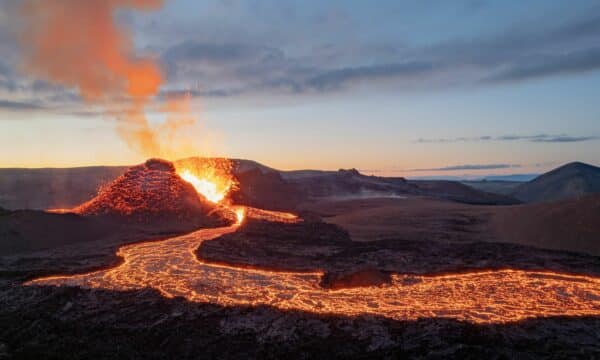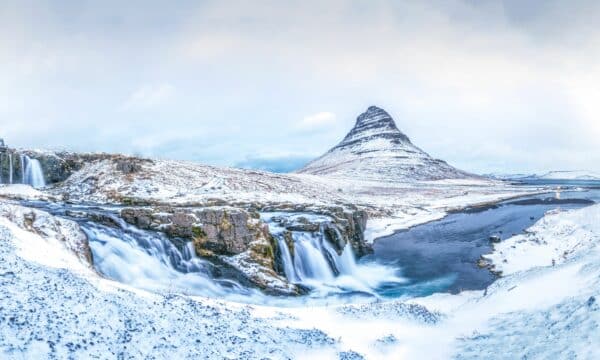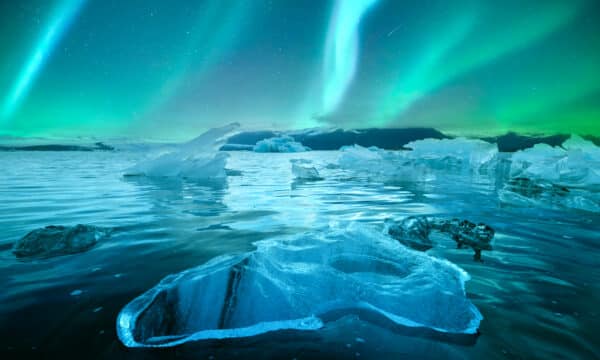- Explore Iceland on a Self Drive Tour
- Feature photo: Orly Orlyson via Flickr
Translating to “Bay of Houses”, Húsavík is Iceland’s oldest settlement. The Viking Garðar Svavarsson briefly resided there in 870 AD, a few winters before the country’s first permanent settler, Ingólfur Arnarson, ever set foot in Iceland.
Today, Húsavík is best known as ‘The Whale Watching Capital of Iceland’. Lately, it has found greater fame as the setting of Will Ferrell’s new comedy film Eurovision Song Contest: The Story of Fire Saga (2020).
Húsavík is both part of the Diamond Circle sightseeing route, as well as the Arctic Coast Way, a 900 km (560 mi) journey that winds through the fjords of North Iceland.
Where is Húsavík?
The harbour town of Húsavík lies by Skjálfandi Bay in North Iceland. The name of this bay translates to “Shaky Bay” or “Trembling”, and it is believed the ancient settlers who named it did so after the many earthquakes in the area.
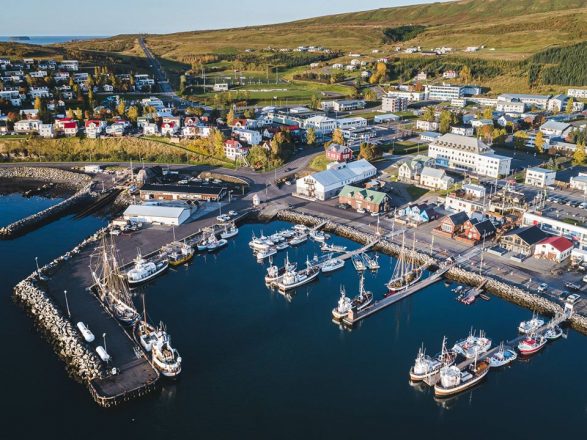
Húsavík town is about 463 kilometres (288 mi) from Iceland’s capital, Reykjavík, and it takes around 6 hours to drive there nonstop.
Along the way is a wealth of beautiful attractions, so we highly recommend you take your time getting to Húsavík. Notable detours en-route include the waterfalls Hraunfossar and Barnafoss and Krauma Spa, both in West Iceland, and the Icelandic Seal Centre and Hvítserkur rock stack in the North West.
Húsavík has an airport with only one scheduled airline, Ernir, and one destination, Reykjavík city. However, the nearby town of Akureyri not only has the largest domestic airport in the North but also scheduled international flights.
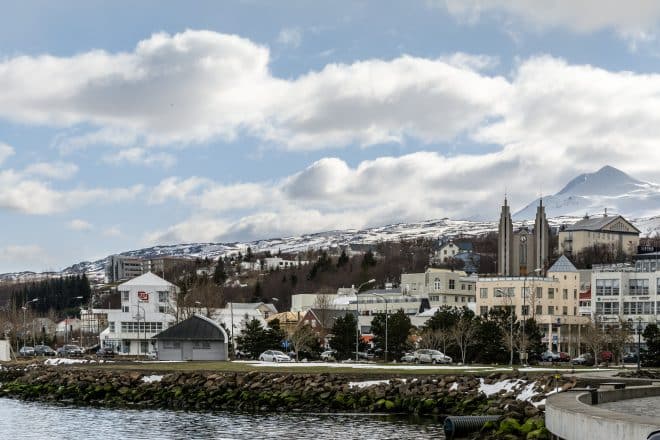
Akureyri is the largest settlement in North Iceland and is only 75.5 km (47 mi) from Húsavík.
The summers in Húsavík are temperate, but the winters can be quite cold, as they tend to be in all of North Iceland. This is because of the North’s proximity to the Arctic Circle. Húsavík town itself is about 58 kilometres (36 mi) from the Arctic Circle.
- Read about Winter in Iceland here
The 7 Top Things to do in Húsavík
Húsavík is a tight-knit community of just over 3,000 people, with their main income coming from fishing and tourism.
Aside from exploring the beautiful Húsavík harbour — and watching the colourful boats bob up and down with the waves — visitors will find plenty of exciting activities in and around Húsavík.
1. Whale watching
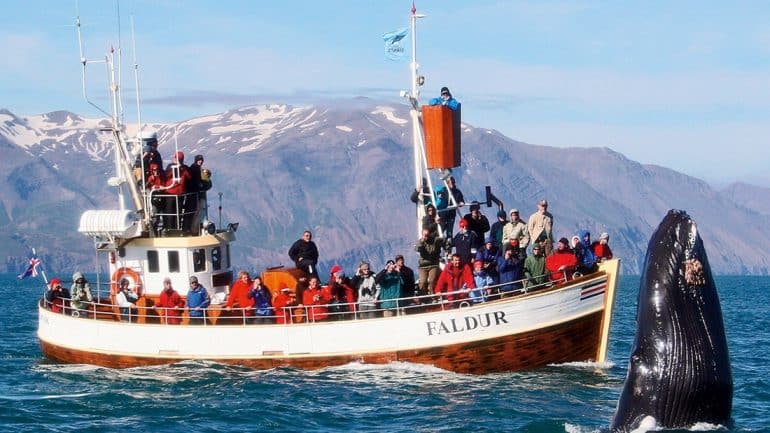
Húsavík is known as the ‘Whale-Watching Capital of Iceland’, as the waters of Shaky Bay are home to over 20 species of whales and dolphins.
- Find a Whale Watching tour here
The most common cetacean species are humpback and minke whales, white-beaked dolphins, harbour porpoises, and the mighty blue whale.
Many whale watching guides agree that the humpback whales are among the most entertaining of the marine animals in Icelandic waters. Their playful nature provides whale watchers with spectacular displays where they can see them jumping out of the water, slapping their flippers against the sea, or poking their heads up to see what’s nearby.
The sighting rate on excursions like this in Húsavík is around 98%. If you happen to be unlucky and not spot any on your tour, most companies offer you a chance to join another whale watching tour at another time.
2. Whale museum
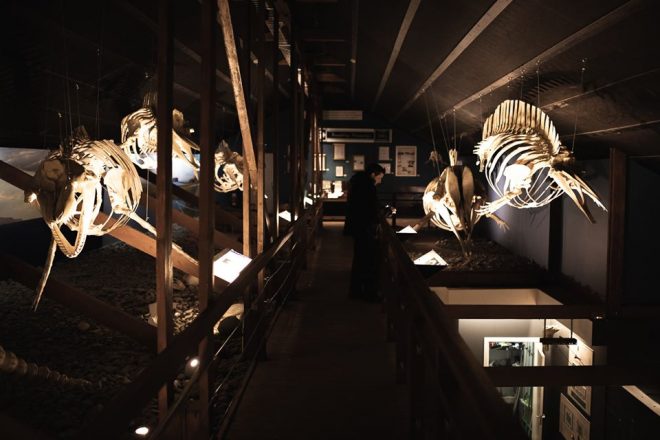
Those who just cannot get enough of whales should check out Húsavík’s Whale Museum.
Here you can learn more about whales, as well as about marine ecology and the interactions of whales and humans throughout history, including the history of seafaring in Iceland.
The exhibits are designed to give you the impression you are walking underwater, making it easier to imagine the animals in their own habitat.
Informative videos and displays are scattered around 1,600 m2 (17222 ft2) museum, but the highlight is probably the massive blue whale skeleton which hangs from the ceiling.
3. GeoSea
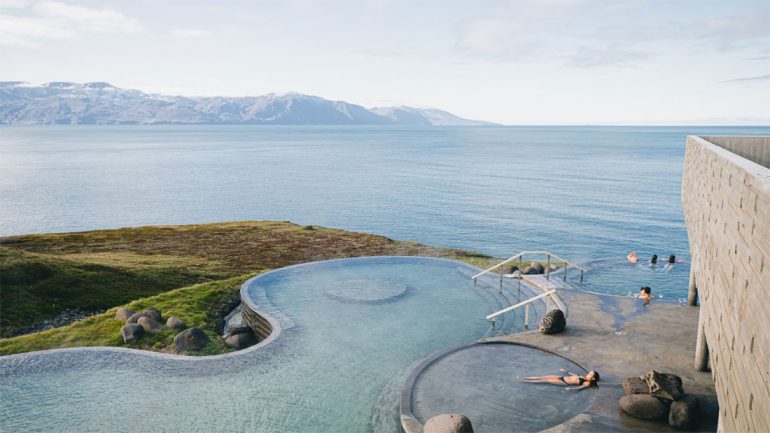
The nature around Húsavík is nothing short of spectacular. The mountain, Húsavíkurfjall, watches over the town and one could spend hours staring out onto the fjord at the rolling waves of the North Atlantic.
One of the best ways to experience this gorgeous scenery is with a dip in the GeoSea Geothermal Sea Baths in Húsavík.
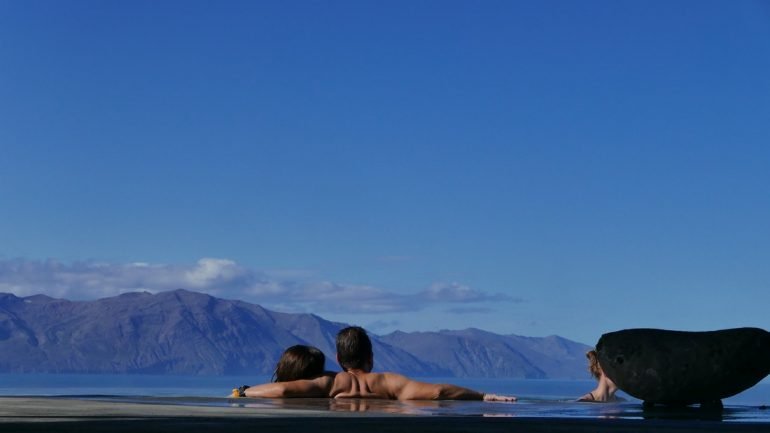
This luxurious spa is built into a cliffside which overlooks the Skjálfandi Bay. This means that while you let geothermally heated seawater caress your skin, you can also watch out for whales breaching out in the ocean.
4. The Exploration Museum
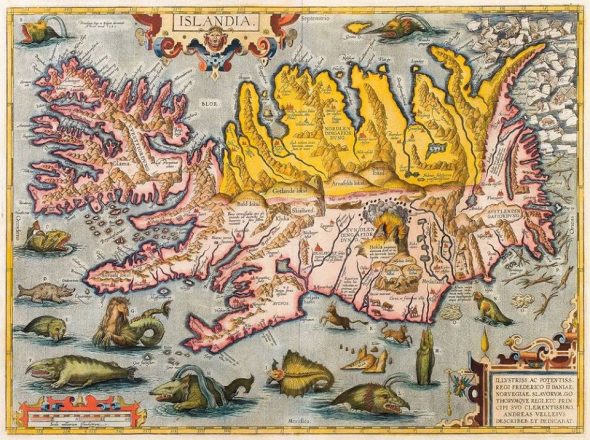
As the name suggests, The Exploration Museum is dedicated to the history of human explorations; from Eric the Red and Christopher Columbus to Amelia Earhart and Neil Armstrong.
Surprisingly, it wasn’t Viking Garðar Svavarsson (first Nordic settler of Iceland) who inspired this museum. It was actually the 1969 lunar mission.
In 1965 and 1967, astronauts of the Apollo program, which included Neil Armstrong, came to Iceland to train for their moon mission.
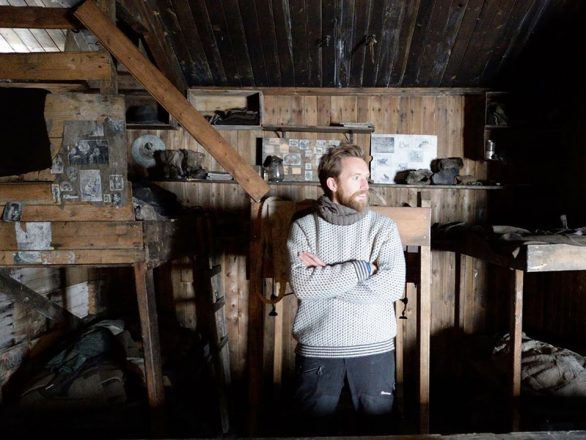
Thanks to Iceland’s volcanic geology and lack of vegetation, the landscape here resembles that of the moon, making it the perfect place for astronauts in training.
The museum focuses on the various accomplishments and feats achieved by brave men and women as they crossed oceans or polar ice caps, climbed mountains or left the earth behind.
5. Húsavík Church
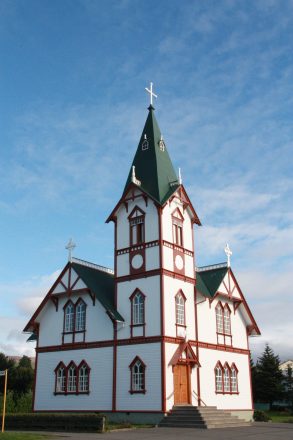
Those visiting Húsavík will, no doubt, notice the unique, white church situated close to the harbour.
Húsavíkurkirkja church is a wooden church inaugurated in 1907. It was designed by Rögnvaldur Ólafsson, Iceland’s first architect.
Ólafsson was a prolific architect and designed a number of buildings all over Iceland, including the stone churches at Þingeyri (North Iceland) and Bíldudalur (Westfjords)
The style is called Swiss chalet, which was a popular style at this time, and you can see a few houses in that style dotted around downtown Reykjavík.
6. Mærudagar (Candy Days)
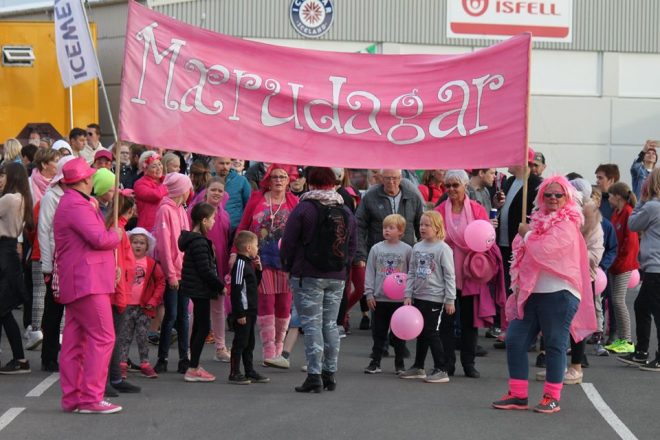
The Húsavík town festival, Mærudagar, has been an annual event since the early 90s (with the exception of 2020 due to Covid-19) and usually held during the last weekend of July.
During the festival, the town is divided into three districts. Each one decorates their houses, businesses, lampposts, streets, and even their residents in a specific colour, and each neighbourhood tries to outdo the other two.
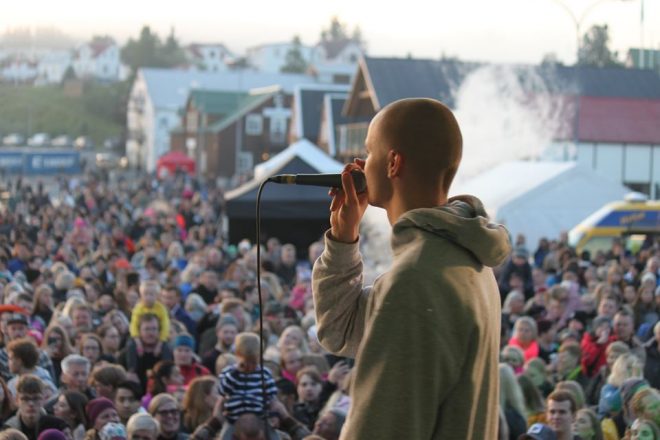
You can hear live music all over town and dotted around are art exhibitions, open-air theatre, and markets.
Restaurants and shops are open for longer during the festival. In the evening, the people gather at the harbour to listen to good music and enjoy themselves.
7. Húsavík Lighthouse
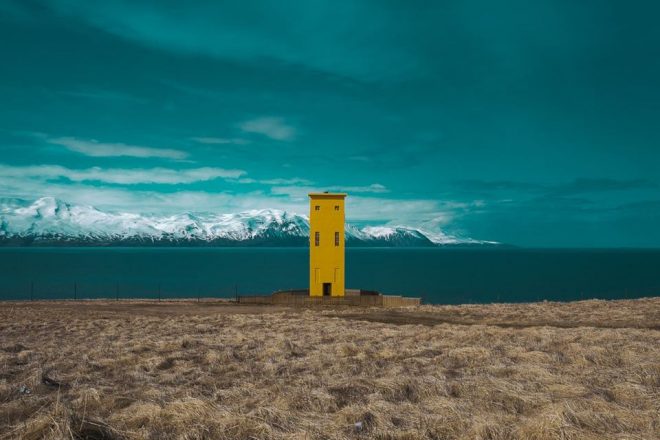
The yellow lighthouse, Húsavíkurviti, stands just outside the town. With the backdrop of blue mountains and even bluer Atlantic Ocean, this picturesque lighthouse makes for a great stop for those looking to boost their social media with something colourful yet dramatic.
The 12 metre high (39 ft) lighthouse was built in 1956 and stands at 49 metres (160 ft) above sea level. It is located near the GeoSea spa but is still considered one of Húsavík’s hidden gems.
The Diamond Circle
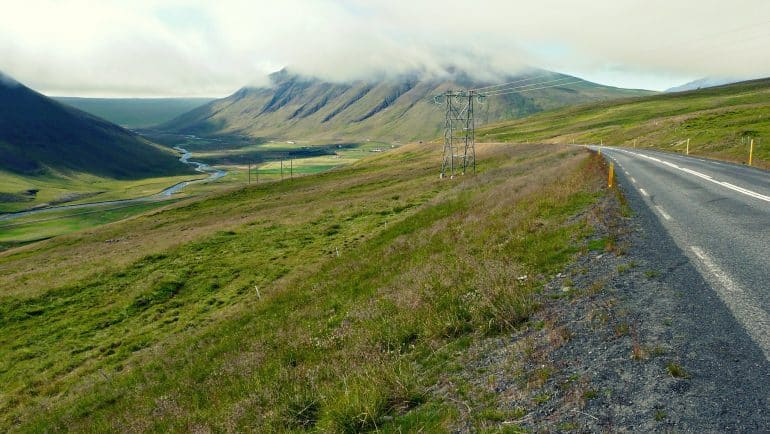
The town of Húsavík is part of the Diamond Circle, a 260 kilometre (162 mi) sightseeing route which has sometimes been described as the North’s answer to the Golden Circle.
- Read about South Iceland’s Golden Circle
The four other sites that make up the Diamond Circle are Lake Mývatn, Ásbyrgi Canyon, and the waterfalls Dettifoss and Goðafoss.
Lake Mývatn

Lake Mývatn is Iceland’s fourth-largest lake. It’s a stunning body of water with unique geological features and abundant birdlife.
The term ‘Mývatn’ is also used to describe the volcanic region in North Iceland near the lake itself, which was created in a series of eruptions some 2,000 years ago.
Amongst the notable attractions in the Mývatn area is the Dimmuborgir lava field, a natural labyrinth of black rocks and, according to folklore, home of the Yule Lads.
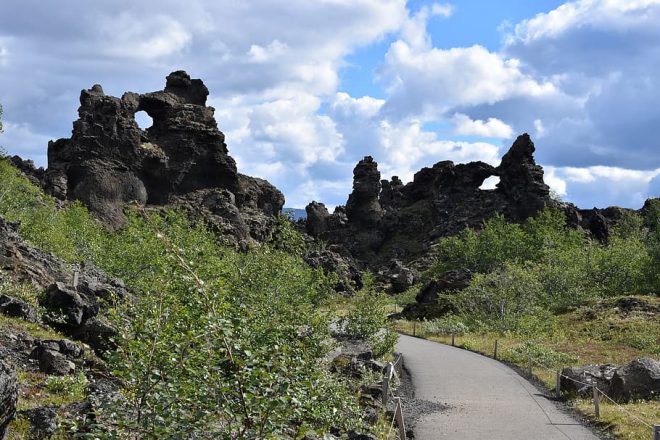
Námaskarð pass is another must-see stop when travelling around Mývatn. This geothermal region is nothing short of otherworldly. The ground has been coloured red by minerals in the earth and dotted around are hissing steam vents and bubbling mud pools.
Here, you can also find the Mývatn Nature Baths, a geothermal spa which utilises the area’s volcanic power to create the perfect bathing temperature for its visitors.
- Book a visit to the Mývatn Nature Baths here
Dettifoss Waterfall
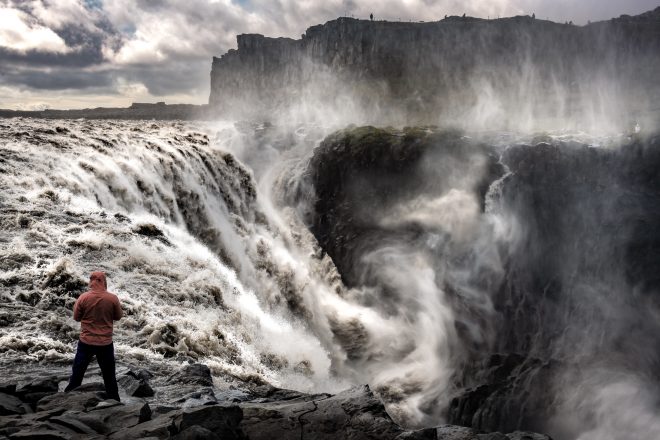
Dettifoss is Europe’s most powerful waterfall, at 44 metres (144ft) tall, 100 metres wide (328 ft), and with a flow rate of 500 cubic metres per second (that’s a whopping 17,657 ft3).
It is easy to see this dynamic cascade’s awesome power, but visitors can also feel it by placing their hands on the nearby rocks and sensing the vibrations.
The waterfall’s dramatic scenery has caught the attention of Hollywood. Sci-fi fans might recognise it from the 2012 Ridley Scott film, Prometheus, or the 2013 movie Oblivion, starring Tom Cruise.
Visitors can admire the waterfall from an observational platform, which not only overlooks the fall but the surrounding countryside as well. However, the mist from the cascade might get you a little wet, so make sure you bring a raincoat.
Dettifoss is found about 90 kilometres (56 mi) from Húsavík and 152 km (94 mi) from Akureyri.
Ásbyrgi Canyon
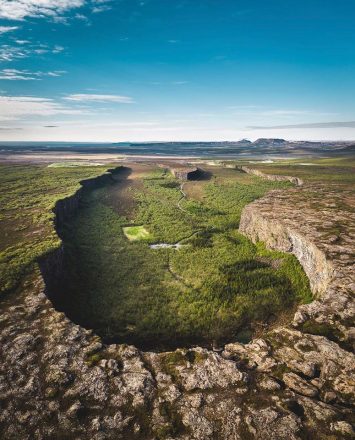
Located only about 38 kilometres (24 mi) east of Húsavík, the glacial canyon, Ásbyrgi, is steeped in both natural beauty and folklore.
According to geologists, the canyon was formed shortly after the last ice age in cataclysmic glacial floodings of the river Jökulsá á Fjöllum. However, the Viking settlers had another explanation.
In ancient folklore, this place is where Odin’s horse, Sleipnir, touched the ground with one of his eight legs, creating this horseshoe-shaped canyon. The mystical features of Ásbyrgi don’t end there; still today the canyon is believed to be the home of elves and hidden folk.
Ásbyrgi is a hiker’s paradise. Here you’ll find numerous paths and tracks which allow you to explore the canyon’s steep 100-metre (330 ft) cliffs and the woodland found within them.
Goðafoss Waterfall
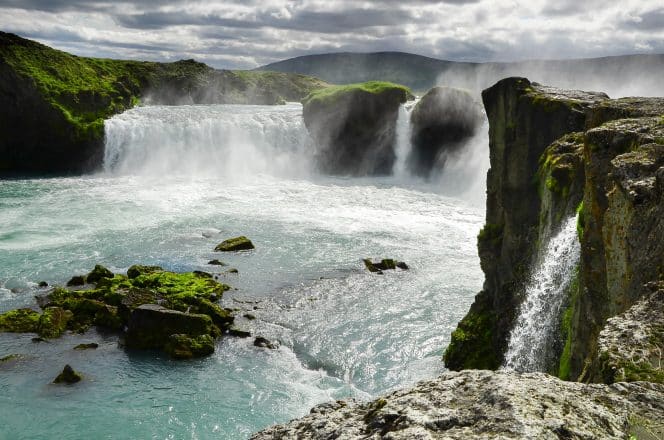
A short drive away from the Mývatn Area, and right before you reach Akureyri, you’ll find the beautiful Goðafoss Waterfall.
The name translates to ‘Waterfall of the Gods’. The reason for this is both because of the cascade’s devine look and because of its history with the Christianization of Iceland.
In the year 1000, a pagan priest and a political figure, Þorgeir Ljósvetningagoði was given the task of deciding whether the country should embrace this new religion or continue worshipping their native gods. He chose the former, and to symbolise this decision, threw his idols of Norse gods into the waterfall.
Goðafoss falls down a 12 metre (39 ft) high arch-shaped cliffs which stretch out 30 metres (98 ft.). The backdrop of cloud-covered mountains gives the whole scene a dramatic but elegant look.
Goðafoss is about 47 kilometres (29 mi) from Húsavík but only 36 kilometres (22 mi) from Akureyri.
The Arctic Coast Way & Nearby Attractions
Húsavík is part of the Arctic Coast Way, a stretch of road which runs approximately 900 kilometres (560 mi) from the northwestern town of Hvammstangi to Bakkafjörður fjord in the northwest. It winds between 20 other towns and villages, four islands, and countless natural wonders.
Off the Arctic Coast Way, near Húsavík, you’ll find even more natural attractions and fascinating spots.
Akureyri
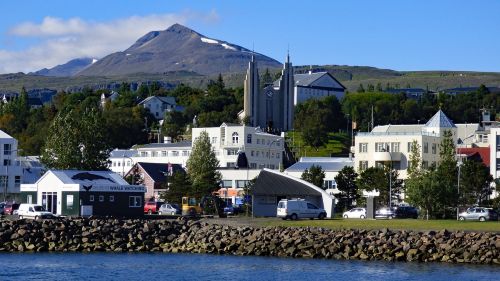
The largest settlement in North Iceland, Akureyri, is home to around 19.000 people and located on the Arctic Coast Way.
It is a cultural hub of the North and has a robust nightlife with several bars, pubs and restaurants. Here you can also find various museums such as the Akureyri Art Museum, Akureyri Museum of Industry, a motorcycle museum, and the Aviation Museum of Iceland.
Towering over the town is the Akureyri Church, the landmark building of the Akureyri. It was built in 1940 and designed by famed Icelandic architect Guðjón Samúelsson, responsible for such constructions as Hallgrímkirkja church and National Theatre in Reykjavík.
In Akureyri, you’ll also find a botanical garden and the northernmost 18 hole golf course in the world.
Akureyri is approximately 75 kilometres (47 mi) from Húsavík.
Lake Botnsvatn
Just outside of Húsavík, you’ll find a gorgeous lake, Botnsvatn.
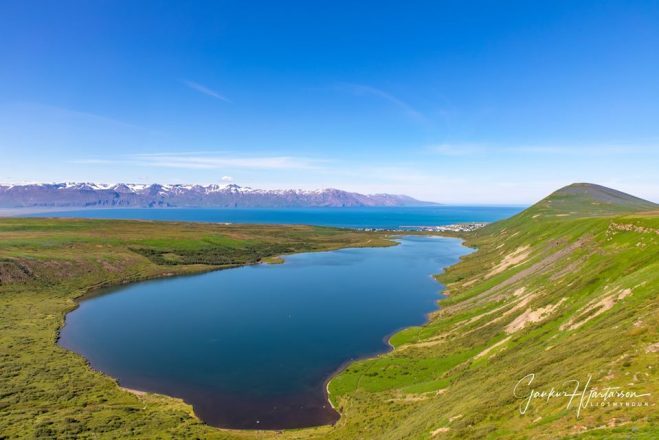
There are several walking trails around the lake and plenty of fish in it. Unlike many of the lakes in Iceland, fishing in lake Botnsvatn is actually free.
The lake’s surroundings are peaceful and beautifully framed with snow-capped mountains. In late summer and autumn, you are bound to find plenty of blueberries and mushroom to pick.
Lake Botnsvatn is only about 1.6 kilometres (1 mi) from Húsavík.
Ystafell Transportation Museum
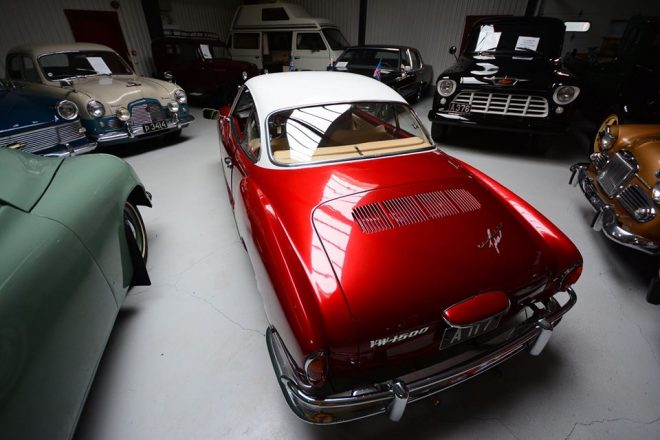
Located between Húsavík and Akureyri, Ystafell Transportation Museum features a collection of vintage cars and trucks. Its main role is to preserve and show various means of transportation throughout the centuries in Iceland.
Iceland has more motorized vehicles than people, and at Ystafell, you get to get close to some of the old gems which include a 1914 model.
Ystafell museum is 1.8 (1 mi) kilometres from Húsavík.
Where to stay and what to eat in Húsavík
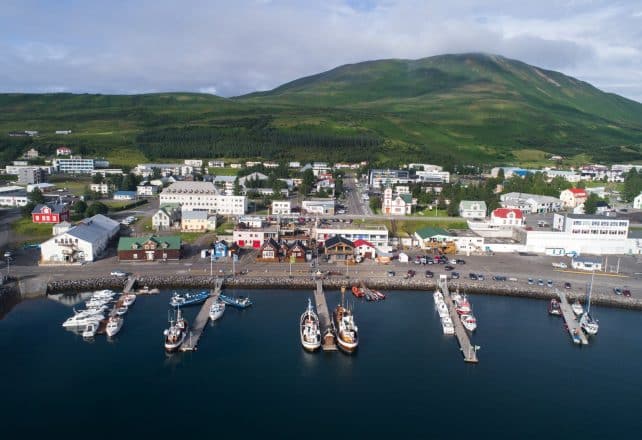
When staying in Húsavík, you’ll be spoilt for choices with hotels, hostels, guesthouses, and cottages all available year-round.
Those looking to stay in Húsavík can contact us at Traveo, and we can find the best place for you within your budget.
Húsavík has both shops and supermarkets, and for those looking for a nice place to sit down and eat, there are plenty of options. Here are the top 4 cafes and restaurants listed on Tripadvisor:
1. Naustið
Naustið is a family-run restaurant located in downtown Húsavík, known for its excellent seafood menu which is stacked with super-fresh fish.
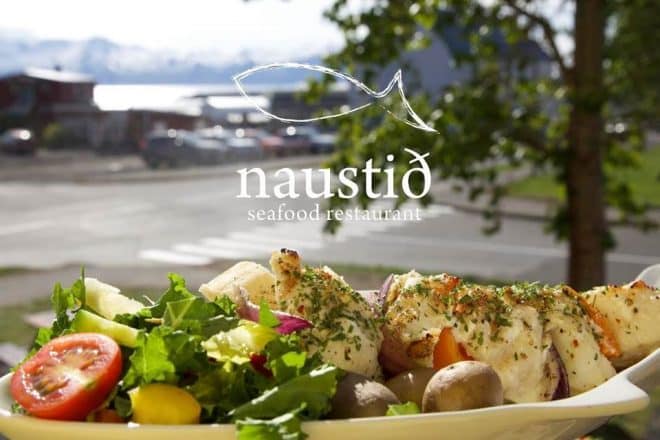
Location:
Ásgarðsvegur 1
Opening hours:
- Monday: CLOSED
- Tuesday: 12 – 1 PM, 5:30 – 9 PM
- Wednesday: 12 – 1 PM, 5:30 – 9 PM
- Thursday: 12 – 1 PM, 5:30 – 9 PM
- Friday: 12 – 1 PM, 5:30 – 9 PM
- Saturday: 12 – 3 PM, 5:30 – 9 PM
- Sunday: CLOSED
2. Fish and Chips
Located on Húsavík harbour, Fish and Chips is a small window-front which serves delicious fish and chips. Sometimes, simple ideas work best, and this is undoubtedly true in this case.
Location:
Hafnarstétt 19
Opening hours:
Every day 11:30 AM – 8 PM
3. Restaurant Salka
Restaurant Salka can be found in a historic building which used to house Iceland’s first cooperative.
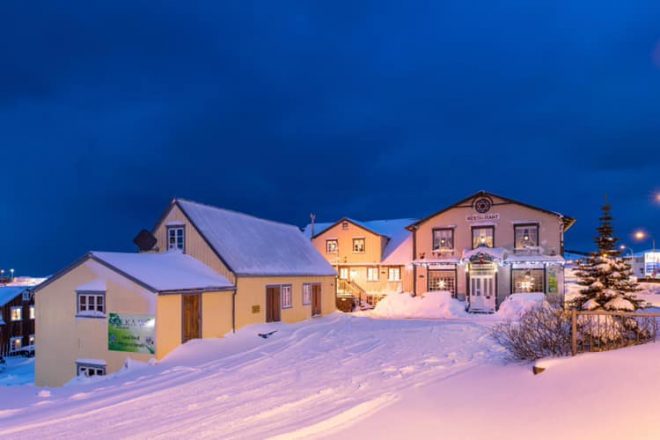
Here you’ll find a variety of items on the menu from fresh fish and pizzas to veggie options and burgers.
Location:
Garðarsbraut
Opening hours:
Every day 11:30 AM – 9:00 PM
4. Gamli Baukur
Gamli Baukur not only serves delicious seafood and lamb but is located in a beautiful wooden building by the harbour, making it also an ideal place to snap a few photos as well.
A large terrace and live music make this one of the best places to be in North Iceland in the summer.
Location:
Hafnarstétt 9
Opening hours:
Every day 12:00 PM – 9:00 PM
5. Heimabakarí Konditori
Who doesn’t love a good bakery? Freshly baked bread, sandwiches and lots of sugary cakes and pastries.

Location:
Garðarsbraut 15
Opening hours:
- Weekdays 7 AM – 5 PM
- Saturday 9 AM – 4 PM
- Sunday 10 AM – 4 PM
Húsavík & Eurovision Song Contest: The Story of Fire Saga
The new Netflix movie, Eurovision Song Contest: The Story of Fire Saga, starring Will Ferrell and Rachel McAdams takes place in Húsavík.
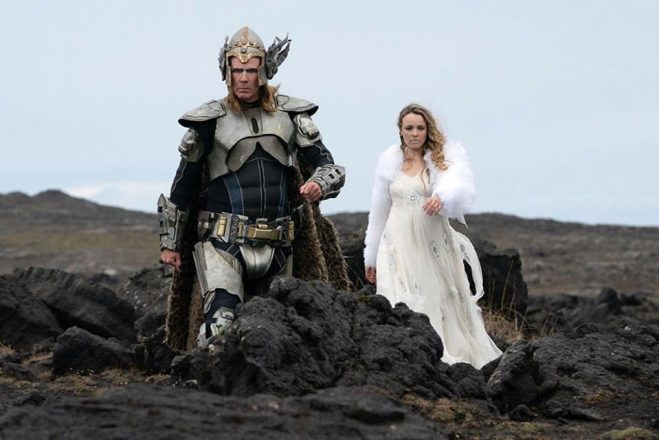
The movie revolves around two pop-star singers from Húsavík who chase their dream of making it to the international song competition, Eurovision.
The movie was filmed in Húsavík last summer. It stars — alongside Ferrell and McAdams — many of Iceland’s best-known actors, including Ólafur Darri Ólafsson from the Trapped series (which was filmed in another North Iceland town, Siglufjörður).
You can see shots from iconic places in Húsavík which include the harbour and the Húsavíkurkirkja church. The movie also shows Shaky Bay’s resident whales, albeit they were created by CGI.
One of the songs in the movie was even named after Húsavík, and it has these fantastic lines describing this lovely North Iceland town:
Where the mountains sing through the screams of seagulls
Where the whales can live ’cause they’re gentle people

